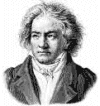
Ludwig van Beethoven
Ludwig van Beethoven wrote 32 piano sonatas, sonatas that spanned all of his adult creative life. All of them masterpieces, yet apart from a half dozen nicknamed few, they are not often heard. There is genius beyond the
Moonlight, the
Appassionata and the
Pathetique!
Recording all of the Beethoven sonatas is a herculenean task. In style, they range from the Haydnesque classical to breaking new ground in the Romantic. In spirit they vary from simple, childlike sonatinas, to some of the most profound music Beethoven ever wrote.

Artur Schnabel
Artur Schnabel was the first pianist to record a complete cycle between 1932 and 1935, and for many these renditions still remain the gold standard. The set opened up this new world of Beethoven to the those who wanted to explore further. Since then, of course, many great pianists have recorded the complete Beethoven piano sonatas, most notably Alfred Brendel who has recorded the complete cycle three times!
The final five sonatas are known as the late sonatas, were written late in Beethoven's life. He was completely deaf, and constantly ill. Like the other works in this period (the ninth Symphony, the
Missa Solemnis and the late string quartets) they are the most personal and powerful music he wrote. It is almost as if his deafness has forced him to write music not for others, but to achieve the essence of the art.
A brief outline of just two of the sonatas:
The Hammerklavier Sonata
Beethoven labelled all of the final five piano sonatas as
Hammerklavier. To the non-German speaker, this implies that the sonatas are to be played in a percussive, hammered manner. Actually, Beethoven was simply leaving instructions that they should all be played on the relatively new Hammerklavier or pianoforte (which has hammers striking the strings) and not the old-fashioned harpsichord (which has plucked strings).
The nickname
Hammerklavier has stuck with just one, the massive piano sonata no.29 opus 106, in B flat major. The
Hammerklavier is immense in time (it plays for over three quarters of an hour), in scope, and in technical demands.
It opens with a vigorous series of doubled dotted chords which dissolve into a cascade of rippling notes. These two ideas alternate with various, ever complex harmonic distortions. As a reprieve, a short scherzo follows.
Then come the two most remarkable movements, the first a massive adagio, in a style never before tried, predating the impressionists. It has very little in the way of a theme or melody. Instead it is a series of feelings, thoughts, stream of consciousness even. Sometimes an idea moves forward, but without definite purpose, then a deep stillness is all that is left, sometimes flowing, then slowing. The final movement is a fugue, contrapuntally one of the most complex written by Beethoven, much feared and pronounced by more than one pianist as unplayable.
Sonata No.32 Opus 111
Beethoven's final numbered work, while less famous than many of his others, is one of his greatest and most profound.
It is set up as two contrasting movements. The first is dark, threatening, even sinister with brief rays of light blotted out by the stormy undercurrent. There is a questioning tone that is never fully answered or resolved.
Then comes the second movement, one of the most peaceful pieces of music ever written by any composer. This is an almost too simple theme that is followed by ever more emotionally complex variations until they transport the listener to the greatest heights that music can attain. Is this Beethoven accepting his life with all its trials and his nearing end?
It is this work, perhaps more than any other that had the greatest influence on the future of music. Here is the origins of not just Schubert, his immediate successor, but also Liszt, Mahler, Wagner and even Prokofiev.
Maurizio Pollini

Maurizio Pollini
Maurizio Pollini has never recorded the entire cycle, but his recording of the final five piano sonatas has become almost legendary. His piano technique is most related to that of Glenn Gould, but without the eccentricities: exceptional clarity, articulation and pedalling, and phrasing that breathes new life into the most well-known works.
Beethoven left very thourough and clear instructions on how the play his final piano sonatas, and Pollini follows them to the letter. These are not virtuoso Romantic showpieces. They are the final testament of a great man suffering great adversity and yet slowly, quietly, complexly coming to terms with his end. They are full of emotion, but more in the sense of discovering a new religious awakening than any human anguish.
This is music at its most profound, most elevating, most life changing. Here performed by a pianist fully aware that he cannot improve upon Beethoven, but plays him with all the reverence and skill it deserves.
Please support Good-Music-Guide.com
by purchasing this CD using this link.

Track Listing
Ludwig van Beethoven
The Late Piano Sonatas
Maurizio Pollini
DISC 1
Sonate No. 28 A-dur, op. 101
- Etwas lebhaft und mit der innigsten Empfindung. Allegretto, ma non troppo
- Lebhaft, marschmässig. Vivace alla Marcia
- Langsam und sehnsuchtsvoll. Adagio, ma non troppo, con affetto - attacca
- Geschwinde, doch nicht zu sehr und mit Entschlossenheit. Allegro
Sonate No. 29 B-dur, op. 106 - Grosse Sonate Fur Das Hammerklavier
- Allegro
- Scherzo. Assai vivace
- Adagio sostenuto. Appassionato e con molto sentimento
- Largo - Allegro risoluto
DISC 2
Sonate No. 30 E-dur op.109
- Vivace, ma non troppo
- Prestissimo
- Gesangvoll, mit innigster Empfindung (Andante molto cantabile ed espressivo)
Sonate No. 31 As-dur op.110
- Moderato cantabile molto espressivo
- Allegro molto
- Adagio ma non troppo - fuga, ma non troppo
Sonate No. 32 c-mol op.111
- Maestoso - Allegro con brio ed appassionato
- Arietta. Adagio molto semplice e cantabile